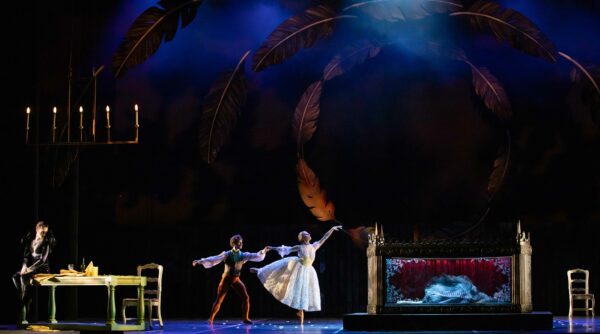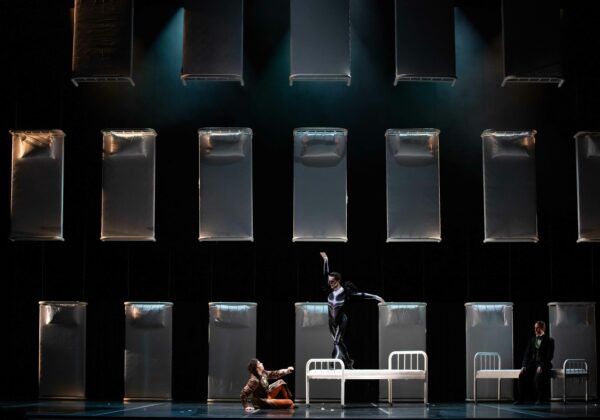
Ballet Austin’s production of “Poe: A Tale of Madness.” Photo: Anne Marie Bloodgood, courtesy of Ballet Austin
To create his latest work, a ballet that weaves together Edgar Allan Poe’s life and famous writings, Ballet Austin’s Artistic Director Stephen Mills assembled a team of collaborators from among Austin’s most exciting performing arts creatives. The result is a mysterious web of dance storytelling that explores madness, trauma, and loss, some of the themes Mills has returned to time and again throughout his career in works like Hamlet and the Light/The Holocaust & Humanity Project.
This ballet’s story is the product of a concept by Stephen Mills and a libretto (which refers to plot more than dialogue, as the only word spoken in the ballet is Edgar’s whispered name) by Shawn Sides, who is the co-producing artistic director of experimental theater company Rude Mechs.
When it begins, Poe (Paul Martin) is at death’s door, ailing in the hospital, and in his delirium, hallucinates a collage of emotionally charged scenes from his life and moments of horror from his fiction. Throughout the ballet’s two acts, he is haunted by Death (Edward Carr), the Raven (Ian J. Bethany), and the Imp of the Perverse (James Fuller), a mirror image of Poe representing his self-destructive impulses. The purpose of this doubling isn’t initially clear, but Mills explained in a post-show Q&A that in this conception, Poe’s tragedy is that his traumas, including the deaths of his mother and young wife, prevent him from getting out of his own way.
In addition to grief, during this vision of Poe’s final moments, his professional problems continue to plague him. The New York Literati and The Folio Society break up the darkness of Poe’s world, partying and sneering in pink and green costumes while leaping around Poe with interest, then relegate him to the margins of the publishing world. Their sharp, curious movements contrast the lyrical choreography of the supernatural characters and the tortured movements of Poe and other ill people he remembers.

Ballet Austin’s production of “Poe: A Tale of Madness.” Photo: Anne Marie Bloodgood, courtesy of Ballet Austin
The plot ambitiously layers characters, memories, and the unreal, but both Margaret Mitchell’s costumes and Michael B. Raiford’s set design, complemented by Tony Tucci and Erin Earle Fleming’s lighting design, help to make sense of this haunted world by blending abstract and period elements. Death lurks in a cape covered with ghoulish faces that turns red in an act two allusion to The Masque of the Red Death, and the Raven’s costume emphasizes bones while Poe is costumed in a period dressing gown. Backdrops include feather elements, extending the presence of the famous raven and evoking Poe’s writing quill, while deaths are marked by characters’ descents into ornate coffins. Raiford builds this world and then slashes through it as a pendulum, the dangerous blade the protagonist of Poe’s The Pit and the Pendulum narrowly escapes, swings across the stage. Its design features two bright, electric parallel lines that contrast everything else onstage.
In some of the ballet’s most striking moments, including the pendulum reveal, the score seems to literalize Poe’s descriptive language. In this moment, composer Graham Reynolds captures what Poe calls “the hissing vigor of its dissent,” as it swings “far and wide — with the shriek of a damned spirit!”
Poe marks the fourth full-length collaboration between Mills and composer Graham Reynolds, and the first with a symphony, with Peter Bay conducting the Austin Symphony Orchestra. He guides the audience through Poe’s world with dramatic, layered trombones and percussion.

Ballet Austin’s production of “Poe: A Tale of Madness.” Photo: Anne Marie Bloodgood, courtesy of Ballet Austin
The heart of the ballet comes from Sissy, Poe’s first cousin, who he married when she was thirteen and he was twenty-six. Stephen Mills conflates her with Annabel Lee, the titular character of Mills’ favorite Poe poem, who, chilled and killed by jealous angels, remains in her husband’s dreams. Danced by Grace Morton, and costumed in yellow, she is a joyous presence who idolizes her husband but fades fast from illness, devastating Poe.
As the ballet concludes, so does Poe’s life. In one final thrill, from within his coffin, Poe’s chest pulses with the percussive rhythm of a heartbeat. With a final screech the pendulum swings past, ending the show. But the presence of Edgar Allan Poe in Austin extends beyond the Long Center (where this world premier took place). The Harry Ransom Center on UT Austin’s campus holds seventy letters written by Poe, a lock of his hair, and his desk.
The ballet is an effective enticement to delve deeper into Poe’s life and work, balancing human pain and otherworldly terrors.
Ballet Austin’s Poe: A Tale of Madness played at The Long Center in Austin on March 22, 23, and 24, 2024.


